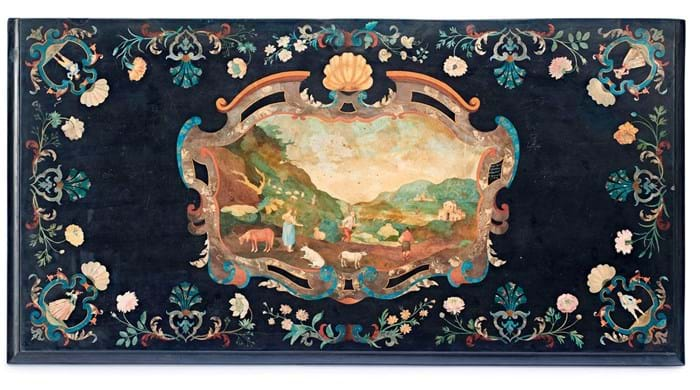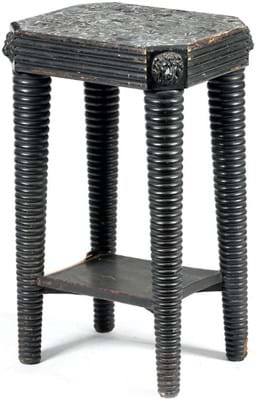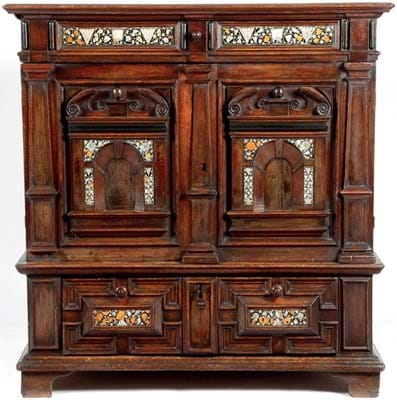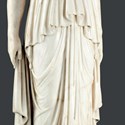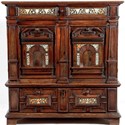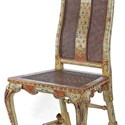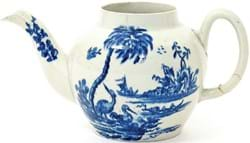The £653,000 total and 89% success rate on the 705 lots offered on January 9 suggest the omens are good.
“It was a spectacular start to the year with many great results,” said Suzy Becsy of the furniture, works of art and clocks department. “The sale ranks as the department’s most successful ever.”
Stripped of many of the less commercial lots in the antique furniture sphere, it was an engaging offering.
The core of the sale was 165 lots from the collection of the lawyer and academic Sir Jeremy Lever QC, whose name is widely known in the arts and antiques fraternity.
Now 85, he has been downsizing for a while. His collection of Worcester porcelain was dispersed by Bonhams in 2007-08 and further pieces were sold at W&W two years ago.
Grand Tour grips buyers
The main strengths of this offering – 147 entries were sold to a total £258,000 – were the marbles and bronzes led by a pair of white marble Grand Tour, Greek-style caryatids.
Dated to the late 18th or early 19th century, and either French or Italian, the 3ft 1in (94cm) tall classical maidens may originally have been bases for candelabras or torchères. Estimated at £5000-8000, they sold to a UK dealer at £18,000.
Nineteenth century Italian Grand Tour pieces featured strongly among the bronzes, including an ‘after the antique’ 2ft 4in (71cm) tall model of Rome’s Farnese Hercules which went comfortably above estimate selling to a bid from a British collector on thesaleroom.com at £8000.
Topping the bronzes, however, was an even larger Art Deco work by Bruno Zach, a 4ft 6in (1.37m) figural lamp of a standing nude with a Corinthian column fitted with three lights. Signed to the black marble base, it was created by the Ukrainian-born artist c.1925 and, against a £5000-8000 estimate, it sold privately at £10,000.
Sir Jeremy’s highly decorative French ormolu mantel clocks that had furnished his former home, Manwood House in Sandwich, Kent, met a tougher market. Several failed to get away.
Best of the Lever clocks was an Empire ormolu mantel clock signed Leroy Palais Royal no.114 à Paris to a circular enamel dial inset within a wheel of Minerva’s chariot. It went a shade above top estimate in selling to a British collector at £6500.
Owned by Dirk Bogarde
A 3ft 1in (94cm) diameter mid 19th century Italian table top inlaid with radiating panels of specimen marbles was a good example of its type.
It also came with a Hollywood provenance, having been owned by actor Dirk Bogarde, who displayed it in both his country house near Godalming in Surrey (1962-65) and the Provençal farmhouse where he lived from 1972-86.
Pitched at £15,000-20,000, it seemed a decent buy for a European dealer – one of many currently enjoying the benefits of the weak pound – at £14,000.
From another source was a rare Florentine Grand Tour scagliola table top with a central landscape panel signed and dated Petro. Belloni. Vallumbrosa. A Florenta. F. Anno. D 1754.
Don Pietro Belloni was the assistant of the abbot at Vallombrosa, Don Enrico Hugford, who is widely acknowledged as the master of scagliola and credited with changing it from a humble folk craft to an art form. His work for English clients is well documented.
The table top at Salisbury, measuring 2ft 4in x 4ft 7in (71cm x 1.4m) was estimated at £20,000- 30,000 and sold to the Continental trade at the lower figure.
Baroque-style, but 19th century, a Florentine ebony and ebonised pietra dura cabinet more than doubled the mid-estimate in selling to a UK dealer at £9500. Taking it to an imposing 9ft (2.76m) high was a bronze bust of Cosimo de Medici.
Two mid-17th century Flemish pieces – an ebony and tortoiseshell cabinet on stand (estimate £10,000- 15,000) and an inlaid oak enclosed chest (estimate £2000-3000) – took solid sums.
Supplied with ebony from Cadiz and oil paintings by the many talented artists living in the city as members of the Guild of St Luke, Antwerp was the leading centre for the manufacture of similar cabinets such as this.
The 12 panels to this example, depicting figures in landscapes, were in the manner of Hans Jordaens III. It sold at a lower-estimate £10,000 to the Continental trade.
The more restrained chest was decorated with ebony panels and marquetry and inlaid with mother of pearl and bone including cartouches reading CGE and 1646. It made £11,000, selling to a UK dealer.
Home-grown offerings
Among the best-received home-grown offerings was a late 17th-early 18th century Welsh oak and marquetry press cupboard elaborately, if naively, carved all-over with birds, scrolling grapevine and stylised leaves and flowers. Estimated at £800-1200, it sold at £4800 on thesaleroom.com.
Strong competition emerged too for a Regency ebonised occasional table, with a 17 x 14in (44 x 35cm) marble top and ring-turned legs (a 10-times-estimate trade bid of £4800), while a rare pair of Queen Anne white and polychromed Japanned side chairs estimated at £7000-10,000 sold to a private bidder for £11,000.
They were in the manner of the documented London early 18th century furniture maker John Ball.
Mirror eyecatcher
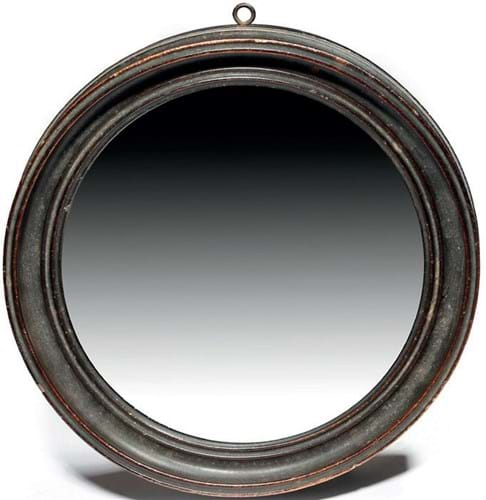
William IV ebonised shaving wall mirror sold for £3600 at the Woolley & Wallis auction on January 9.
While the 30 mirrors of all shapes and sizes offered at W&W were led by a flamboyant Rococo-style pair of William IV carved giltwood pier mirrors at a below-estimate £4500, the eyecatcher was a very plain ebonised shaving wall mirror from the same period.
The 9½in (24cm) concave mirror had a label to the back reading J Abraham Optician & Mathematical Instrument Maker to His RH the Duke of Gloucester and His Grace the Duke of Wellington, 7 Bartlett Street Bath.
Its former owner was the purser William Mark, whose career from 1801 included serving under Nelson and culminated with the post of HM Consul in Malaga. The mirror remained in the family until consigned to the Salisbury sale where, against a £400-600 estimate, it sold to the trade for £3600.


